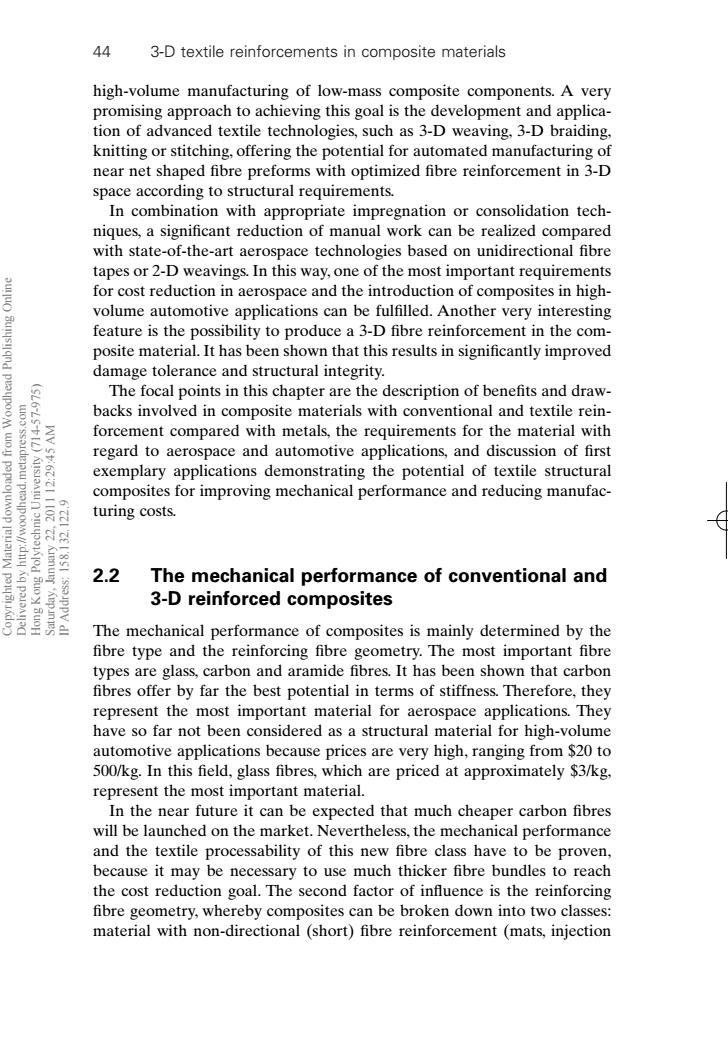正在加载图片...

44 3-D textile reinforcements in composite materials high-volume manufacturing of low-mass composite components.A very promising approach to achieving this goal is the development and applica- tion of advanced textile technologies,such as 3-D weaving,3-D braiding, knitting or stitching,offering the potential for automated manufacturing of near net shaped fibre preforms with optimized fibre reinforcement in 3-D space according to structural requirements. In combination with appropriate impregnation or consolidation tech- niques,a significant reduction of manual work can be realized compared with state-of-the-art aerospace technologies based on unidirectional fibre tapes or 2-D weavings.In this way,one of the most important requirements for cost reduction in aerospace and the introduction of composites in high- volume automotive applications can be fulfilled.Another very interesting feature is the possibility to produce a 3-D fibre reinforcement in the com- posite material.It has been shown that this results in significantly improved damage tolerance and structural integrity. 9 The focal points in this chapter are the description of benefits and draw- backs involved in composite materials with conventional and textile rein- forcement compared with metals,the requirements for the material with regard to aerospace and automotive applications,and discussion of first 容t exemplary applications demonstrating the potential of textile structural composites for improving mechanical performance and reducing manufac- turing costs. 2.2 The mechanical performance of conventional and 3-D reinforced composites 8 The mechanical performance of composites is mainly determined by the fibre type and the reinforcing fibre geometry.The most important fibre types are glass,carbon and aramide fibres.It has been shown that carbon fibres offer by far the best potential in terms of stiffness.Therefore,they represent the most important material for aerospace applications.They have so far not been considered as a structural material for high-volume automotive applications because prices are very high,ranging from $20 to 500/kg.In this field,glass fibres,which are priced at approximately $3/kg, represent the most important material. In the near future it can be expected that much cheaper carbon fibres will be launched on the market.Nevertheless,the mechanical performance and the textile processability of this new fibre class have to be proven, because it may be necessary to use much thicker fibre bundles to reach the cost reduction goal.The second factor of influence is the reinforcing fibre geometry,whereby composites can be broken down into two classes: material with non-directional (short)fibre reinforcement (mats,injectionhigh-volume manufacturing of low-mass composite components. A very promising approach to achieving this goal is the development and application of advanced textile technologies, such as 3-D weaving, 3-D braiding, knitting or stitching, offering the potential for automated manufacturing of near net shaped fibre preforms with optimized fibre reinforcement in 3-D space according to structural requirements. In combination with appropriate impregnation or consolidation techniques, a significant reduction of manual work can be realized compared with state-of-the-art aerospace technologies based on unidirectional fibre tapes or 2-D weavings. In this way, one of the most important requirements for cost reduction in aerospace and the introduction of composites in highvolume automotive applications can be fulfilled. Another very interesting feature is the possibility to produce a 3-D fibre reinforcement in the composite material. It has been shown that this results in significantly improved damage tolerance and structural integrity. The focal points in this chapter are the description of benefits and drawbacks involved in composite materials with conventional and textile reinforcement compared with metals, the requirements for the material with regard to aerospace and automotive applications, and discussion of first exemplary applications demonstrating the potential of textile structural composites for improving mechanical performance and reducing manufacturing costs. 2.2 The mechanical performance of conventional and 3-D reinforced composites The mechanical performance of composites is mainly determined by the fibre type and the reinforcing fibre geometry. The most important fibre types are glass, carbon and aramide fibres. It has been shown that carbon fibres offer by far the best potential in terms of stiffness. Therefore, they represent the most important material for aerospace applications. They have so far not been considered as a structural material for high-volume automotive applications because prices are very high, ranging from $20 to 500/kg. In this field, glass fibres, which are priced at approximately $3/kg, represent the most important material. In the near future it can be expected that much cheaper carbon fibres will be launched on the market. Nevertheless, the mechanical performance and the textile processability of this new fibre class have to be proven, because it may be necessary to use much thicker fibre bundles to reach the cost reduction goal. The second factor of influence is the reinforcing fibre geometry, whereby composites can be broken down into two classes: material with non-directional (short) fibre reinforcement (mats, injection 44 3-D textile reinforcements in composite materials RIC2 7/10/99 7:24 PM Page 44 Copyrighted Material downloaded from Woodhead Publishing Online Delivered by http://woodhead.metapress.com Hong Kong Polytechnic University (714-57-975) Saturday, January 22, 2011 12:29:45 AM IP Address: 158.132.122.9